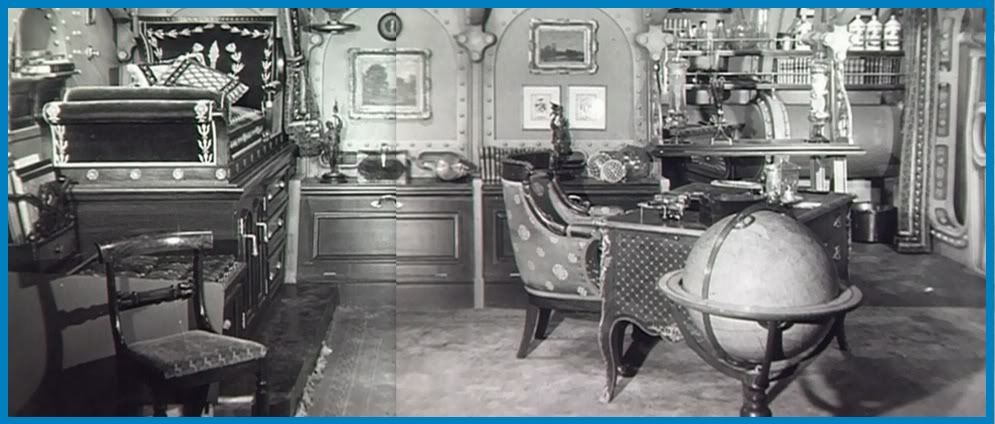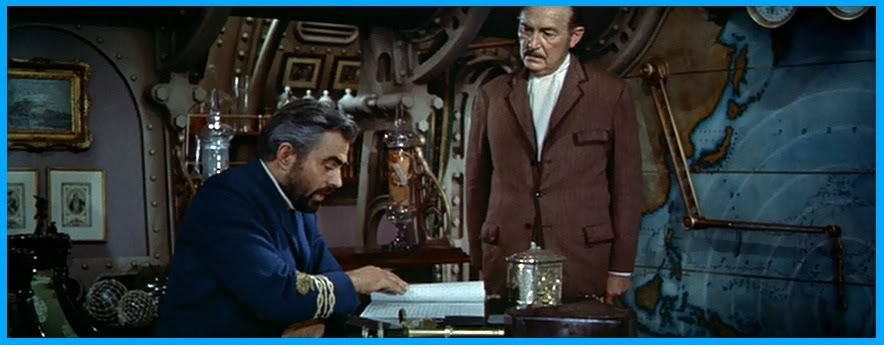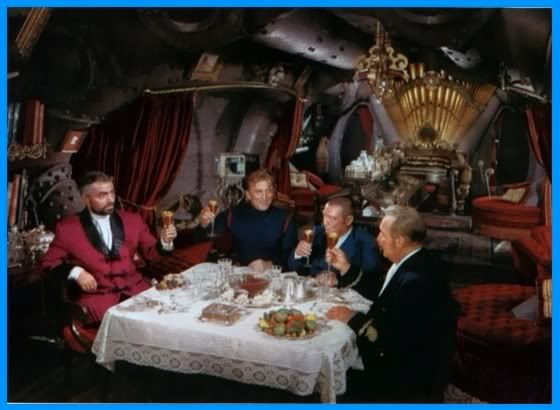Captain Nemo's underwater mechanical marvel, The Nautilus, as featured in Walt Disney's "20,000 Leagues Under the Sea", is our featured interior this week because it is a wonderous example of Jules Verne inspired "Steampunk" set design.
"20,000 Leagues Under the Sea" was released in 1954 and was a bonanza at the box-office. It won an Academy Award for its stunning special effects ( including all those underwater diving sequences ) and for its Color Art Direction. Which as you can see below, it justly deserved.
John Meehan, the art director for this film had won 3 Academy Awards in his career for such beautiful films as Sunset Boulavard, and The Heiress. During the late 1950s he turned to television set design and worked on Alfred Hitchcock Presents, The Millionaire, Soldiers of Fortune and Leave It To Beaver.
Working alongside with him on "20,000 Leagues" was Emile Kuri, a very well known set decorator of numerous Walt Disney features. This was the beginning of his long association with the studio, but prior to this film he had worked as set decorator on many, many fine pictures : It's A Wonderful Life, I Remember Mama, A Place in the Sun, Fancy Pants, A Place in the Sun, War of the Worlds, Carrie, Shane, etc, etc.
Emile Kuri will be featured in a blog entirely devoted to him, right now let's begin our grand tour of the Nautilus....
The Structure of the Nautilus
The Nautilus had three different levels : the first containing the workings of the ship ( the ballasts, pump room, and power supply ) as well as the Outfitting Room and Diving Chamber. This is where Captain Nemo and his blue crew would prepare themselves for sojourns beyond the Nautilus, such as underwater hunting expeditions, outer hull repairs, and those not-too-uncommon burials at sea.
The middle level contained the Galley, where delictable delights such a Seaweed Salad were prepared for Nemo and his guests, as well as the Passenger Cabins. For common "seaman" this was nothing more than a bunk and washstand in a room enclosed with pipes, but for more distinguished guests ( such as the Professor ) it was quite decorative with a wood carved bed, mahoghany desk, and even pictures on the wall. Ooohh.
 |
| The Main Dining Room |
In the center of the salon was a display case which might of included specimens from some of Captain Nemo's hunting expeditions. And beyond this was the grand feature of the salon - the circular viewing window. Although Nemo had works of art scattered throughout the Nautilus this viewing window showed the most beautiful picture of all : the wonderous world of the deep.
The Captain's Quarters
But even though the Nautilus was a beautiful submarine throughout ( albeit a bit overly iron ) the BEST decorated room of all was Captain Nemo's very own quarters. After all, it was his ship so why not have the best suite?
This lovely room was cheerful and yet quite masculine in style. Nemo slept on a traditional sea captain's bed which was a single bed atop numerous drawers ( something we all should use ). He had a magnificently ornate writing desk, a globe of the world at hand, and a map of his world - the underwater world - hanging opposite his desk.
 |
| Captain Nemo's Room |
 |
| James Mason and Paul Lukas |
For the making of "20,000 Leagues Under the Sea" several different sized models of the Nautilus were made. A full-scale replica was built for the filming of the interior sequences. Shortly after the film was released, a 20,000 Leagues Under the Sea attraction opened at Disneyland. Visitors could see the largest of models on display, read about Nemo's important scientific research he was conducting, walk thru a replica of the sets used in the film, and awe at the giant squid about to attack your sub....all for only 10 cents.
 |
| Disneyland's 20,000 Exhibition |
 |
| The Main Salon, from the 20,000 Leagues Exhibit |
 |
| The mighty organ that played those eeeeerie tunes |
Six years after "Twenty Thousand Leagues Under the Sea" premiered another version of The Nautilus was designed for Ray Harryhausen's adventure extravaganza "Mysterious Island" starring Gary Merrill, Joan Greenwood, and Michael Callan and Herbert Lom as our mysterious Captain Nemo. This one designed by art director Bill Andrews. The design of the ship was obviously copied off of 20,000 Leagues because the main lounges are very similiar in style. The "working" part of the ship was different though and included an aquarium where Nemo demonstrated a method of how the stranded passengers could rescue a sunken pirate ship and return to civilization.
 |
| Herbert Lom, as Captain Nemo in "Mysterious Island" |
 |
| The Outfitting Room of the Nautilus as seen in Mysterious Island (1929 ) with Lionel Barrymore |
** Note** : This was just a reprint of a post that I wrote back in January for my "Drafting a Design" blog. I've been too pooped to post lately..but I'll come up with something fresh soon.





No comments:
Post a Comment